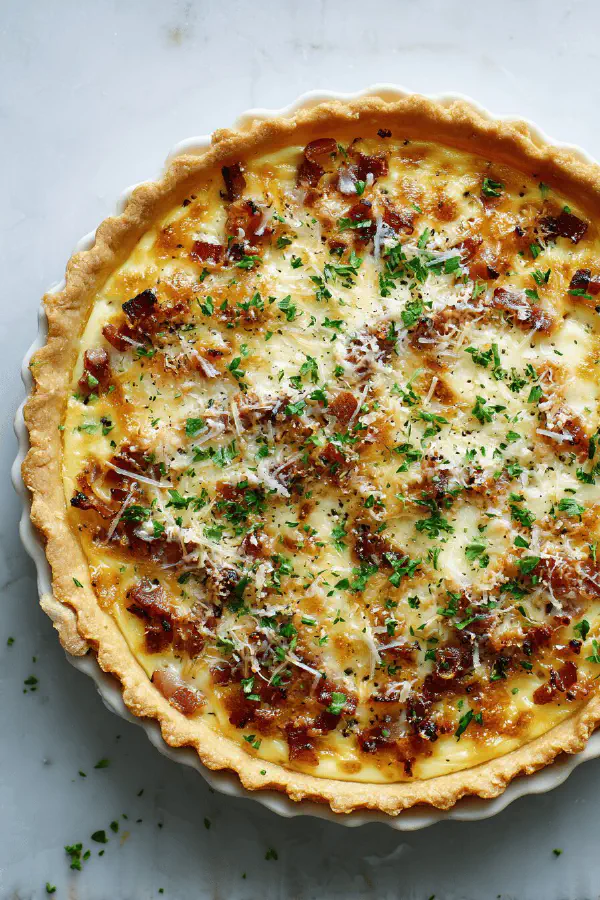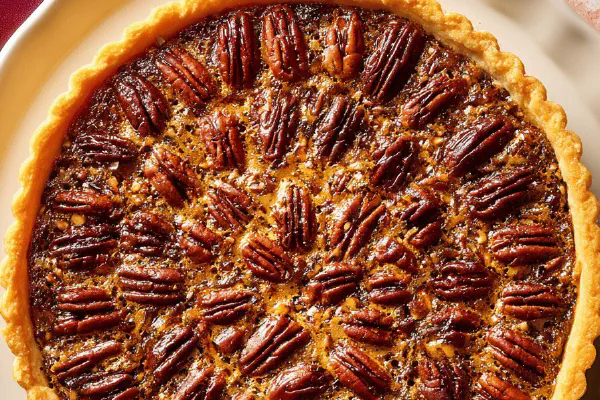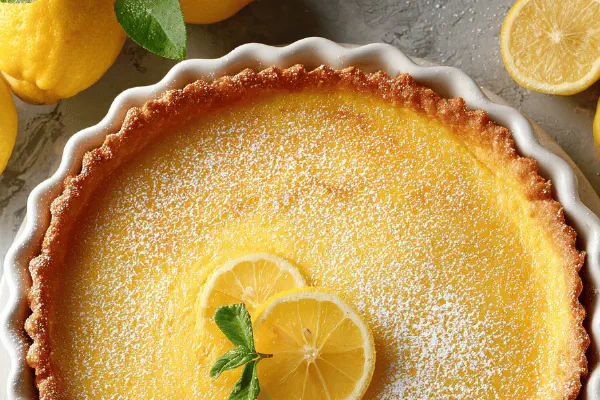Alsatian Flambé Tart Twist

By Kate
Ingredients
Dough
- 280 g all-purpose flour
- 6 ml instant yeast
- 6 ml salt
- 140 ml lukewarm water
- 160 ml pale ale, room temperature
- 2 large yellow onions, thinly sliced
- 20 ml neutral oil
- 100 ml crème fraîche, room temperature
- 180 g smoked pancetta, diced 1 cm
- 60 g grated Emmental cheese
- Freshly ground black pepper
Filling
About the ingredients
Method
Dough
- Start by mixing flour, yeast, and salt in a bowl or stand mixer with dough hook. Slowly add water and beer; stir till it just comes together. Don’t rush the liquid addition—too fast, flour lumps. Stick to room-temp beer; cold stalls yeast.
- Transfer dough to floured surface; knead 6-7 minutes. Dough should be soft, smooth, slightly tacky, not sticky. Too dry? Splash water sparingly; too wet? Dust flour in small doses. Avoid over-kneading; gluten development key for good rise but no rubbery crust.
- Shape dough into a tight ball. Oil bowl lightly; place dough seam side down. Cover with damp cloth or plastic wrap sprayed with oil to prevent sticking. Let rise in warm spot (around 25°C) for about 1 hour 50 minutes. The goal: double volume, airy feel. Too cool—rise slows; warm spot near stove or oven is good.
- While dough proofs, sweat onions gently in oil over medium-low heat. Don’t let them brown right away; just translucent and soft, almost melting. This brings out sweetness without bitterness. Taste for seasoning; salty onions throw the balance off.
- Use smoked pancetta instead of bacon; less greasy, smoky depth. Cook pancetta in separate pan over medium heat till edges crisp. Drain excess fat on paper towels.
- Preheat oven to 250°C with pizza stone or inverted heavy baking tray on center rack. High heat critical for blistered bottom and crisp crust.
- Divide dough into two portions. Flour surface lightly; roll each into an irregular oval roughly 35 x 20 cm. Not exact, rustic is fine. Place on parchment paper. Cover loosely with inverted baking sheet or plastic wrap. Let rest for 12-15 minutes. Short rest prevents dough shrinkage but allows slight relaxation for easy stretching.
- Spread crème fraîche evenly over dough, leaving 1 cm border. Season generously with freshly cracked black pepper—this layers flavor sharply.
- Scatter softened onions over cream. Distribute pancetta evenly. Then sprinkle grated Emmental instead of Gruyère for nuttier, gentler melt that doesn’t overpower.
- Use parchment paper to slide tart onto hot stone. Bake one at a time, 7-12 minutes. Watch closely: edges should bubble golden brown, cheese should blister but not burn. The crust surface should feel dry and sound hollow when tapped lightly with spatula.
- Remove with a peel or spatula, cool slightly—flambé style best warm but not scorched. Cuts easiest when rested briefly, topping gels slightly but still creamy.
- Repeat for second tart. Serve in rustic slices. If dough too soft to shape properly, chill 10 minutes. If cheese browns too fast, tent with foil after 6 minutes to avoid bitterness.
Filling
Assembly and Baking
Technique Tips
Chef's Notes
- 💡 Dough temperature matters. Use lukewarm water; cold stalls yeast. Beer should be at room temperature. Kneading? It's about texture. Soft, slightly tacky not sticky. Gradually add liquid for better incorporation. Too dry? A splash of water fixes that. Over-kneading leads to dense crust; aim for a light, airy feel.
- 💡 Watch onion cooking closely. Medium-low heat, gentle sweating transforms them. Don't rush to brown; let them melt and soften. Sweet much better, balance all flavors. Taste for seasoning as you go. Too salty? Adjust. Pancetta crispy in a hot pan, less greasy than bacon. Drain on paper towels for crispiness.
- 💡 Rest dough between steps. Helps with elasticity, shaping easier. Divide into two different portions, keep one covered while using the other. Relaxing lessens dough shrinkage, stretches easier. Parchment paper helps slide into the oven. If sticking, sprinkle flour. Parchment prevents burning once baking time starts.
- 💡 Bake on hot stone for that blistered base. Preheat oven to 250°C, critical for crispy crust. Edges should bubble. Watch closely, time varies by the oven. Underbake slightly? Residual heat will carry over. Splash cold water in your oven for steam; influences crust texture. Remove gently to avoid soggy bottom.
- 💡 Let tart cool briefly. Not too long; cutting gets messy when too hot. Texture changes as it sits. Creaminess maintained but gels just a touch. If cheese browning too fast, cover with foil midway. Lessen bitterness. If dough too soft, chill briefly before shaping into ovals. Works wonders.
Kitchen Wisdom
How to keep crust from burning?
High heat important for blistering. Underbake slightly at first. Monitor visually, checking edges. If browning occurs, tent with foil during the last few minutes; retains moisture without bitterness. Resting time helps; cool slightly lets crust support the filling.
What's the best way to store leftovers?
Store in an airtight container in the fridge; reheat in oven, microwaving can make soggy. If cooling completely, freeze in slices. Wrap tightly to maintain texture. Thaw in the fridge first; then reheat until warm and edges crisp up.
Alternatives to ingredients?
Crème fraîche can be replaced with sour cream or Greek yogurt slightly thinned. Pancetta swapped with bacon or smoked turkey for lighter fat. Cheese? Gouda works if you're in a bind but affects overall flavor profile. Adjust according to taste preferences.
Onions taste too sharp or bitter?
Quickly remove from heat. If browned, flavor gets off. Sauté in neutral oil gently. Watch temperature; retaining sweetness is key. Shouldn't brown initially. Adjust cooking time, slow down method helps unlock their natural sugars for sweeter depth.



